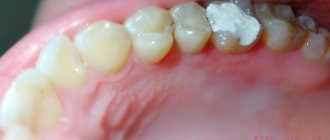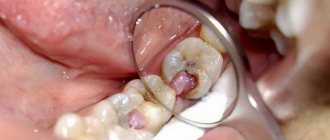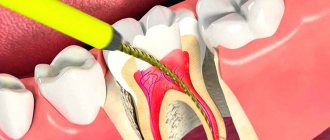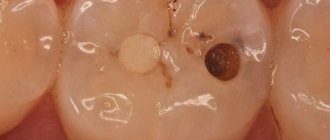Is a refilling necessary if nothing bothers me?
Many patients are surprised when a dentist recommends replacing an old filling with a new one, because they have no pain or other unpleasant symptoms. However, replacement is carried out not only in cases of severe inflammation, but also for preventive purposes, as well as to improve the aesthetics of the dentition.
Like any other material, the filling mass is subject to gradual wear, deformation, and destruction. Hygienic care, oral microorganisms, saliva pH, mechanical, chemical and temperature effects of food over time provoke the appearance of microscopic cracks in the filling. The resulting pores serve as a breeding ground for microbes and the development of dental diseases.
Content:
- Why are temporary fillings placed?
- Why use it - indications for use
- How long can you walk with such protection?
- Manufacturing materials
- How does the installation work?
- Rules of care
- If the coating collapses prematurely
- How does the replacement work?
Often, patients at dental clinics are faced with a situation where the doctor gives them a cheap intermediate filling and indicates the day when they need to come back for a follow-up appointment to replace it with a permanent one. We suggest you understand this treatment tactics and its features.
How long can a filling last?
The service life of a filling is determined by several factors, the main ones being the following:
- correct installation and size,
- characteristics of the material from which it is made,
- the condition of the abutment tooth, the thickness of its walls,
- features of hygienic care: brush hardness, abrasiveness of pastes, etc.
- the presence or absence of certain habits: for example, high consumption of nuts, seeds, opening corks with teeth,
- the predominance of solid and/or tough foods in the diet, and so on.
As a rule, the minimum service life is 3-5 years, but some materials can last 10 years or more. In fact, it depends more on the condition of the treated tooth itself after a while.
How long can you walk with such protection?
Compliance with the terms of wearing is a guarantee that nothing will happen to the tooth. If time is missed, the medicine placed inside the unit will begin to destroy its walls. It will also become leaky, which means that pathogenic microorganisms will begin to actively multiply in the resulting microgaps.
The exact wearing period depends on the characteristics of the material used and the dental diagnosis. The doctor calls him. If we are talking about a paste that destroys nerve tissue, then it is removed after 5-10 days. It happens that you have to repeat the procedure several times, but there is nothing to worry about. If the composition is placed inside the unit to stimulate regeneration processes, then therapy takes about two to three weeks.
Why does caries develop under the filling mass?
The development of a carious process under the filling material is often observed due to poor-quality treatment of the tooth cavity during treatment. The remains of the affected tissues serve as a source of infection, which intensifies and covers increasingly larger areas of the dentition unit.
Caries can also form if the filling is carried out in violation of the protocol. An incorrectly applied composition quickly becomes unusable, losing its fixation with the walls of the tooth cavity or collapsing under the influence of the aggressive environment of the oral cavity. Microbes penetrate into the resulting cracks and voids, which “trigger” the destructive process.
Another factor that provokes the development of caries is the natural “aging” of the filling. The appearance of microdamages (and micropores) on it and in it, which is inevitable over time, contributes to the accumulation of pathogenic bacteria, their reproduction, and the occurrence of recurrent disease. Therefore, it is advisable to replace old fillings with new ones after their expiration date.
Why do you need to fill teeth?
The main task that fillings solve is to prevent the development of carious tooth decay. After high-quality cleaning of the damaged cavity and filling it with a filling, the risk of secondary caries will decrease to almost zero. This allows a person to lead a normal lifestyle and not experience any discomfort. In addition, fillings allow you to restore the aesthetics of your teeth.
Fillings are also used in case of tooth damage due to mechanical stress. This could be a chip from an impact or abrasion of a large layer of enamel.
What types of fillings are there?
Today, various materials are used to fill teeth. The most widespread are the following:
- cement: it is cheap, therefore it is actively used in the budget dental field. Fillings made from this material are susceptible to destruction, short-lived (maximum - 1-2 years), when replacing them, doctors often diagnose a carious process,
- amalgam: based on mercury, copper and silver. They are characterized by high strength, but the appearance leaves much to be desired. In addition, mercury is a toxic substance,
- <>photopolymers: the most modern option. They harden in the light, are durable, highly aesthetic and natural in appearance. On average, they last about five years,
- chemically cured composites: the material cures on its own, without exposure to a blue light lamp (but can still be used to speed up the process). A very durable composition, most often applied to chewing areas - premolars and molars. Aesthetics worse than photopolymers,
- glass ionomer cements: differ from classical cements in a large number of advantages, because They last a long time, the price is not too high, they are low allergenic and can be installed for children.
Chemically cured composites
The main property of chemically cured composites for fillings is their polymerization exclusively when exposed to certain substances. That is, such materials harden evenly after mixing their original components. This makes the filling process more controlled and of high quality, especially when it comes to very deep cavities or extensive carious lesions.
The disadvantages of this material for fillings include the following:
- insufficient resistance, especially under systematic mechanical influence;
- rapid pigmentation and high probability of darkening.
In this regard, such fillings are used less frequently compared to photopolymers.
When is a refilling required?
To determine when a filling needs to be replaced, you should contact your dentist. He will conduct a diagnosis, including x-rays, and, if necessary, carry out a replacement.
Indications for refilling are the following conditions:
- pain in a filled tooth,
- crown destruction,
- detection of caries under filling material,
- feeling of an unpleasant taste,
- decreased aesthetics of the restoration,
- expiration of the seal's service life.
The most common situations in which refilling is required are discussed below.
Changing Hue
Yellowness, darkening and other color changes in the filling (and enamel) most often indicate the presence of a destructive process in the tooth. If there is a reddish tint, it means that the previously installed material contains resorcinol - in this case, not only a refilling is required, but also additional cleaning of the canals, as well as an internal bleaching procedure.
Abrasion of the filling mass
Over time, the fillings wear out, which leads to disruption of the distribution of chewing load. As a result, the bite changes, the load on the temporomandibular joint increases, TMJ pathologies develop, and digestive problems arise.
Overhanging filling
If installed incorrectly, the filling material may “hang” over the adjacent tooth or gum. The accumulation of food particles and impaired contact between units of the dentition provoke an inflammatory process in soft tissues, the proliferation of microorganisms and the development of caries, and bleeding gums.
Subsidence of the filling mass
Shrinkage is typical for any materials used for filling. If it occurs along the axis of the tooth, a person’s bite may change, which will lead to problems with the TMJ and digestion. In addition, vertical subsidence provokes the appearance of cracks and even chips in the tooth, since, as the filling contracts, it “pulls” the hard tissues along with it. When subsidence occurs in the horizontal plane, the degree of contact between adjacent units changes, food debris gets stuck in the interdental spaces, the formation of caries and gum inflammation are observed.
Flat filling surface
If, when filling, the dentist did not pay due attention to the chewing surface, but made it flat, disruption of the chewing process will gradually lead to the development of problems with the gastrointestinal tract. Normally, there are cusps and fissures on it, which ensures full contact with the opposite teeth of the other jaw.
Roughness has appeared
The rough surface of the filling indicates the presence of pores and microscopic cracks in it. This means that microbes have already penetrated into it. Often, when the filling material is removed in such cases, caries is revealed underneath it.
Expired service life
Even if the filling was installed more than 10-15 years ago and still holds, it does not mean that it is fulfilling its function. In the vast majority of cases, when refilling such “rarities”, an extensive carious process is determined.
Unaesthetic appearance
Refilling may be required if the previously installed filling stands out in shade from the background of the remaining teeth. Most often, the situation occurs after the whitening procedure. Over the period of operation, old compounds have absorbed various coloring substances, so to restore the aesthetic appearance (especially of the front units), they need to be replaced.
Problems after installation and their resolution
The process of fixing a temporary filling is not much different from the filling procedure with traditional materials. In both cases, some difficulties may arise. Here are the most common ones:
- soreness: gradually subsiding pain is a completely natural phenomenon, but when it only intensifies, it is better to consult a doctor. This symptom may indicate that the pulp was not completely destroyed, infection and inflammation of the dental tissues. There is also a possibility that the patient has an allergy,
- falling out of the structure: you can’t hesitate - you need to immediately go to a specialist. If you miss the moment, an infection can seep into the internal structures of the tooth, and then negative consequences cannot be avoided,
- strange taste in the mouth: patients encounter this phenomenon when they resort to medicine with a distinct aftertaste for treatment. If the sensations are too intense, this may indicate a crack in the structure - you should see a doctor,
- swelling of the gingival tissue and darkening of the material: clear evidence of incipient inflammation. The situation requires immediate medical intervention.
Such a filling may cause an unpleasant taste in the mouth
. To avoid such problems, it is important to strictly follow all the dentist’s instructions. The appearance of even one of the symptoms described above is a good reason to seek help.
How does the replacement take place?
Many patients are worried: is it painful to change a filling? The procedure is performed under local anesthesia and is therefore absolutely painless.
In general terms, re-sealing occurs as follows:
- anesthesia is administered
- the desired tooth is isolated from the oral cavity with a rubber dam: so that moisture and microorganisms do not enter the treated cavity,
- old filling material and tissues affected by caries (if any) are removed
- the cavity is treated with a special etching solution and dried,
- an insulating or medicinal pad is applied,
- a new filling is applied.
Restoration takes place with mandatory consideration of the anatomical features of the chewing surface.
Features of care after temporary filling
Since temporary filling material is less durable than material for permanent fillings, excessive chewing and thermal stress can lead to its destruction. Therefore it is recommended:
- use a soft toothbrush;
- exclude the use of pastes with aggressive bleaching or polishing compounds;
- after eating, rinse your mouth with antibacterial rinses that were recommended by your doctor;
- exclude chewing gum and other viscous products.
Also prohibited are seeds, chips, and nuts.
How to extend the service life of filling material
How often the filling will have to be changed depends on how correctly it is used. To extend the life of the material, just listen to the following tips:
- don’t skimp on material: very cheap means it won’t last long,
- avoid increased stress on the filling: do not open bottles, avoid excessively hard foods,
- avoid sudden changes in temperature in the oral cavity: do not take too hot or cold food,
- select oral hygiene items and products in accordance with the characteristics of the teeth.
In addition, even in the absence of complaints, you need to regularly visit the dentist for timely detection of pathologies and defects. It is better to spend a few minutes grinding than to have to refill it after some time. Preventative visits will save time and money, and will also keep your nerves and teeth in perfect order.
Our specialists
The specialists of our clinic are dental therapists, surgeons and periodontists, implantologists with extensive practical experience. They use evidence-based medicine and implement the latest developments in dental treatment.
The task of the clinic’s doctors is to preserve the tooth and make the treatment understandable, comfortable and painless. Putting a filling on a tooth means preserving the health of the oral cavity and the whole body. See our price list for the average cost of treatment. The final price is determined only after examination and diagnosis.











